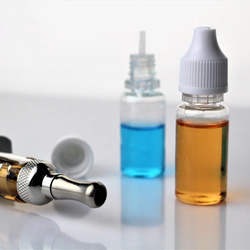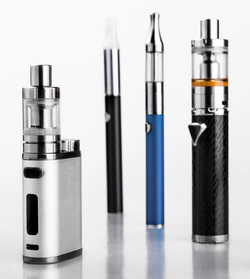Are Youth Vaping Addictive Drugs Right Under our Noses?
Anyone working with teens or young adults should be alert to the possibility of illicit drug use in vaping devices.

Vaping devices intended to replace cigarettes arrived on the shores of America in 2007. The next few years witnessed a back-and-forth negotiation and filing of lawsuits by companies who wanted to penetrate the American market but were being halted by the Food and Drug Administration. This conflict was not settled until 2011.1
While some states, businesses, military bases and airlines have banned the use of these electronic cigarettes, sales increased quickly after the suits were settled. In 2014, more than seven million of these devices were sold. Sales then dipped to around six million units per month but then soared in 2019 to more than 20 million per month.2
Unfortunately, millions of these devices have been purchased by or otherwise made their way into the hands of American youth. While some of the youth prefer mint, menthol or tobacco-flavored liquids in their vaping devices, some of them are using these devices to consume illicit drugs. Because there is so little odor created when vaping, youth have been able to use these drugs right under our noses without anyone realizing what’s going on.
A Closer Look at the Problem
According to a 2022 survey, 2.5 million youth are using e-cigarettes. More than a quarter of them use these devices daily. Some youth are addicted to their e-cigarettes, relying on them as soon as they wake up in the morning. While only 1% of youth were dependent on these devices in 2017, this number rose to 10.3% by 2021.3

Of course, if a young person is abusing an illicit drug in their e-cigarette, they are even more likely to become addicted than if they are vaping nicotine or flavored liquids. Addictive substances found in some of these devices or available on the internet include:4
- Cocaine
- DMT
- Fentanyl
- Hash oil
- Heroin Psychedelics such as LSD
- Marijuana or THC
- MDMA (Ecstasy)
- Methamphetamine
- Synthetic Cannabinoids
- Synthetic Cathinones
Drugs Found in Vaping Devices
Cocaine
Up until several years ago, vaping liquid that contained cocaine or other powerful drugs could be purchased on the dark web, using a site such as AlphaBay. That website was shut down in 2017.5 Users posting on drug abuse forums since that date suggest that there are techniques available to make crack cocaine able to be consumed in an e-cigarette and that dark web sources for liquid cocaine still exist.
DMT
DMT (N,N-Dimethyltryptamine) is a hallucinogenic drug derived from a plant. This is one of the components of a psychoactive tea called ayahuasca that is used in some countries as a religious ritual. Vendors offering vaping devices designed to consume DMT are readily found on the internet.
Fentanyl
A 2018 survey of those using vaping devices found that 7.3% of these users had vaped fentanyl at some point. Scientific literature includes a report of one 36-year-old man arriving at the ER after vaping acetyl fentanyl, and another man dying with a fentanyl-contaminated e-cigarette next to his body.6

Heroin
With heroin too, forums frequented by drug users state that certain forms of heroin can be consumed in a vaping device.
In 2019, two high school students were sickened after smoking heroin-laced solutions in an e-cigarette, leading to the arrest of a local drug dealer. In Pennsylvania, vape pens seized from high school students had been modified so that heroin or fentanyl could be injected into the liquid.7,8
Marijuana or THC
The cannabis industry is already set up to manufacture a dizzying array of smokable or edible forms of THC, so it’s not hard to understand that they would jump on the e-cigarette bandwagon.
A quick search online finds that vaping devices and THC products to consume with this device are readily available. Websites selling these products promote that the consumer can indulge without anyone being able to detect the smell of a cannabis product. Sellers claim that the skunky odor of most cannabis products dissipates almost immediately after they are vaped.
The concentrations of THC available for vaping go as high as 98%. Many devices are designed to consume concentrates and liquids while other electronic devices are for the consumer to smoke dry herb material.
The vaping of cannabis products is quite widespread, not only in the U.S. but also Europe and Canada. 6
MDMA
MDMA is also known as ecstasy. Drug users visiting online forums describe how MDMA can be converted to a form that can be consumed in a vaping device. One survey found that nearly 12% of those who used electronic vaping devices have used them to consume MDMA.
Methamphetamine

The main way that methamphetamine is consumed is via smoking or injection. So having a discreet vaporization device such as one of these e-cigarettes is perfect for someone who wants to consume this illicit drug out in the open without detection.
Meth is consumed by mixing a small amount of the drug into the liquid in the e-cigarette. If a higher proportion of meth is added, then the emissions from the vaping device will smell like meth. Those around the drug user may perceive a chemical, cleaning product or burnt plastic smell. With a small proportion of meth, the only smell will be whatever flavoring has been added to the liquid.
Psychedelics
A 2020 report from Australian researchers noted that three new dark web markets (Cryptonia, Tochka and Agatha) were making vaping supplies that contain illicit drugs available. Among the products being sold were a small number of products containing psychedelics.9
Synthetic Cannabinoids
A report from the U.S. military noted that some service members have been found to be vaping THC or synthetic cannabinoids, a type of drug commonly called Spice. Users reported symptoms like headaches, nausea, vomiting, palpitations, dilated pupils, dizziness, disorientation, agitation, and seizures as a result.10
The Drug Enforcement Administration reports that these drugs can be found suspended in oil that is intended to be used in e-cigarettes.11
Synthetic Cathinones
The drug that has been nicknamed “Bath Salts” also fits into this category. Synthetic cathinones resemble the effects of a plant called khat that is smoked in Eastern Africa and other areas. They are stimulants that can also cause hallucinations.
Identifying Vaping Devices

Vaping devices take many different forms and therefore can be hard to identify. They can look like plastic cigarettes (early models), pens, small boxes with mouthpieces, lighters, USB drives, or smartwatches.
For more information on vaping and a guide to identifying the different generations of vaping devices, click here for a visual dictionary from the Centers for Disease Control and Prevention.12
Vaping and Health
All these drugs have adverse effects on both the mind and the body. But vaping itself creates health risks, some of them serious. Because this industry is so young, the full health effects may not be known for years.
Aside from the advisability of drawing chemicals and drugs into the lungs, the liquids used in these devices are variable and produce a potentially toxic aerosol. Aerosols may also contain contaminants from the device itself such as chromium, nickel and lead. The liquids in the device can produce aerosols of substances like acetaldehyde or formaldehyde which are both toxic and carcinogenic. These toxins have been associated with cardiovascular disease.13
Some of the flavored liquids, which may be used as vehicles for drugs, are associated with “popcorn lung,” an irreversible lung disease.
Thousands of cases of EVALI (e-cigarette or vaping use-associated lung injury) have been reported in nearly all of the U.S. states. The vast majority of those suffering from EVALI admit to vaping, with 80% stating that they were vaping THC. Symptoms of EVALI include shortness of breath, chest pain, cough, fever, fatigue, nausea, vomiting and lung damage.13
The Need to Be Alert to Vaping and Illicit Drugs
Vaping is not going anywhere any time soon, and those who want to get the maximum effects from their drugs are going to continue to share stories with other drug users about how vaping did or did not improve their results.
Parents should be alert to the presence of vaping devices among their children’s possessions, and especially to the possibility that they may be using these devices to consume addictive drugs.
Because of the way vaping devices and e-cigarettes conceal the usual odor of the drugs being used, it’s possible that youth or young adults could take advantage of this fact and use the drugs openly. This possibility should be carefully noted by teachers, parents, coaches, counselors and others who work with youth and young adults.
Sources:
-
Consumer Advocates for Smoke-free Alternatives Association. “Historical Timeline of Vaping & Electronic Cigarettes.” CASAA.org, 2022. CASAA ↩︎
-
Centers for Disease Control and Prevention. “E-cigarette Unit Sales, by Product and Flavor Type—United States, 2014–2020.” CDC, 2020. CDC ↩︎
-
U.S. News. “More U.S. Teens Are Getting Heavily Addicted to Vaping.” U.S. News, 2022. U.S. News ↩︎
-
Idaho State Government. “Cloud Chasing, A Closer Look at the E-Cigarette Epidemic.” Idaho.gov, 2021. idaho.gov ↩︎
-
Department of Justice. “AlphaBay, the Largest Online ‘Dark Market,’ Shut Down.” DOJ, 2017. DOJ ↩︎
-
ScienceDirect. “E-cigarettes—An unintended illicit drug delivery system.” ScienceDirect, 2018. ScienceDirect ↩︎ ↩︎
-
WTAP News. “Man charged in heroin-laced vape sicknesses.” WTAP, 2019. WTAP ↩︎
-
Fox43. “Confiscated vape pens test positive for fentanyl, heroin in Mifflin County School District.” Fox43, 2022. Fox43 ↩︎
-
National Institute on Drug Abuse. “What Vaping Products Can You Pick Up From Online Cryptomarkets?” NIDA, 2020. NIDA ↩︎
-
Marine Corps Community Services. “Vapes and Recreational Drugs: A Deadly Combination.” MCCS, undated. MCCS ↩︎
-
Drug Enforcement Administration. “2020 National Drug Threat Assessment.” DEA, 2021. DEA ↩︎
-
Centers for Disease Control and Prevention. “E-Cigarettes or Vaping Products Visual Dictionary.” CDC, undated. CDC ↩︎
-
National Institutes of Health. “E-Cigarettes and Cardiopulmonary Health.” NIH, 2021. NIH ↩︎ ↩︎






 ®
®